The International Journal of Health Policy and Management (IJHPM) is a distinguished international, peer-reviewed journal dedicated to advancing health policy research and practice. This guide provides a detailed overview of the submission process, article types, and guidelines to help authors prepare and submit manuscripts effectively. IJHPM aims to foster communication among researchers, policymakers, and practitioners, publishing diverse scholarly contributions that enhance our understanding of health policy.
IJHPM Article Types: A Detailed Overview
IJHPM welcomes a variety of article types, each contributing uniquely to the field of health policy and management. All submissions undergo a rigorous double-blind peer-review process to ensure quality and relevance.
1. Editorial
- Purpose: Editorials serve as the voice of IJHPM, offering insightful discussions on key themes within health policy. Written by Editorial Board members, they provide state-of-the-art perspectives on the journal’s core areas.
- Characteristics: Concise and non-descriptive titles. Limited to a maximum of three authors. Refer to Table 1 for detailed specifications.
2. Viewpoint
- Purpose: Viewpoint articles present original, opinion-based perspectives on existing challenges, foundational concepts, or prevalent ideas in health policy and management.
- Characteristics: Short, non-descriptive titles. Maximum of three authors. See Table 1 for further details.
3. Review Article
- Purpose: Review articles, including Systematic Reviews, Meta-Analyses, Meta-Syntheses, Realist Reviews, and Scoping Reviews, offer comprehensive syntheses of existing research.
- Key Requirements:
- Clearly defined inclusion and exclusion criteria.
- Detailed description of study type, intervention, population, exposure, outcomes, and data sources.
- Comprehensive methodology section covering search strategy, selection criteria, data extraction, quality assessment, and data analysis.
- Structured abstract (Background, Methods, Results, Conclusion, Registry Name and Number if applicable).
- Protocol registration with OSF or PROSPERO is highly recommended.
- Adherence to PRESS Peer Review of Electronic Search Strategies: 2015 Guideline Statement for systematic searches (https://www.sciencedirect.com/science/article/pii/S0895435616000585).
- Checklist submission as a supplementary file, ensuring all points are addressed in the text with corresponding page numbers.
- Refer to Table 1 for specific guidelines.
4. Original Article
- Purpose: Original articles present primary research findings that are methodologically sound and relevant to international health policy and management.
- Essential Components:
- Clearly stated objective or hypothesis.
- Detailed study design and methodology (setting, participants, inclusion/exclusion criteria, sampling, data sources).
- Comprehensive data analysis and interpretation.
- Presentation and discussion of main results.
- Addressing study limitations and conclusions.
- Structured abstract (see Abstract Guidelines).
- Ethical Issues/Statement in the method section (blinded) and Title Page. Declaration of reasons if ethical approval was not needed.
- Key Messages section with Implications for Policy Makers and Implications for Public (see Key Messages Guidelines).
- Consult Table 1 for details. Utilize the Sample Word Template for manuscript preparation.
5. Short Communication
- Purpose: Short Communications are concise articles presenting significant preliminary findings that merit rapid publication but may not require a full-length article format.
- Format:
- Subdivided into Background, Methods, Results, and Discussion, written concisely.
- Key Messages are not required.
- Ethical Issues/Statement in the method section (blinded) and Title Page.
- See Table 1 for specifications.
6. Commentary
- Purpose: Commentaries offer critical perspectives on selected IJHPM publications, fostering debate and diverse viewpoints from leading scholars and health system stakeholders.
- Process: Authors of the original article and editors invite commentators to provide insights.
- Refer to Table 1 for further information.
7. Correspondence
- Purpose: Correspondence articles are invited responses to published commentaries, allowing authors of the original articles to engage in further discussion.
- Invitation Only: These are not open for unsolicited submissions.
- Details in Table 1.
8. Letter to Editor
- Purpose: Letters to the Editor are short submissions addressing topics of interest to IJHPM readers, providing a platform for brief communications and discussions.
- Characteristics: Concise and focused.
- See Table 1 for specifications.
- IJHPM Acceptable Checklists:
Ensure to embed table 1 image here if available, otherwise, describe the table briefly in alt text.
Alt text: Table summarizing IJHPM article types, submission criteria, word limits, author limits, APC prices, and abstract types.
IJHPM Business Model: Open Access and Article Processing Charges
IJHPM operates on a Gold Open Access model, making research freely accessible worldwide. To support this model, Article Processing Charges (APCs) are applied to accepted articles.
- APC Range: $700-$1500 (USD), plus applicable taxes, varying by article type (see Table 1).
- Coverage: APCs cover editorial, administrative, technical, and indexing services.
- Payment: Payable by authors or their funders before article acceptance and online publication.
- Exemptions: Invited articles (Editorials, Commentaries, Correspondence) are exempt from APCs.
Table 1: Types of Articles and APC Prices
| Article type | Submission by | Abstract type/word limit | Main text word limit* | Max No of Figure/Table | Max No of Authors | No of Ref | APC (USD)** |
|---|---|---|---|---|---|---|---|
| Editorial | Editorial Board Members | Unstructured/100-150 | 1500-2000 | 2 | 3 | Max 20 | free |
| Viewpoint | All authors | No abstract | 1500-2000 | 2 | 3 | Max 20 | 700 |
| Review Articles | All authors | Structured/250-300 | Max 7000 | 6 | No limit | No limit | 1500 |
| Original Articles (Quantitative) | All authors | Structured/250-300 | Max 6000 | 5 | No limit | No limit | 1500 |
| Original Articles (Qualitative) | All authors | Structured/250-300 | Max 7000 | 6 | No limit | No limit | 1500 |
| Original Articles (Mixed method) | All authors | Structured/250-300 | Max 7000 | 6 | No limit | No limit | 1500 |
| Short Communication | All authors | Unstructured/200-250 | Max 4000 | 3 | No limit | No limit | 1400 |
| Commentary | Invitation only | Unstructured/100-150 | 1000-2000 | 2 | No limit | Max 15 | free |
| Correspondence | Invitation only | No abstract | Max 1000 | 1 | No limit | Max 15 | free |
| Letter to Editor | All authors | No abstract | Max 1200 | 1 | 3 | Max 15 | 700 |
*excluding abstract, keywords, references, Tables, and captions.
**excluding VAT and bank transfer charges.
Waiver and Discount Policy
IJHPM offers APC waivers or discounts under certain conditions:
- LMIC Authors: Corresponding authors based in Low- and Middle-Income Countries (LMICs) may be eligible.
- Reviewers: Reviewers who have completed 5 high-quality peer reviews for IJHPM (assessed by editors) can apply.
Important Note: Waiver/discount requests should be submitted to the journal office ([email protected]) after the first decision and before revised manuscript submission. Decisions are made case-by-case and are not considered before the initial manuscript decision.
Payment Process
- Invoice: Corresponding author receives an invoice with payment methods via email.
- Remittance: Payment should be made by the invoice due date.
- Receipt Upload: Corresponding author uploads payment receipt to the IJHPM portal.
- Publication: Upon receipt confirmation, the accepted manuscript (AAM) is published online.
Contact for Payment Queries: [email protected]
APC Refund and Withdrawal Policies
- Refund Policy: APCs are non-refundable after acceptance and will not be refunded for retractions due to author error or misconduct.
- Withdrawal Policy: No charge for withdrawals before the first decision. Withdrawals after the first decision incur a 50% APC withdrawal fee.
* APC prices and guidelines are subject to change.
Pre-publication Guidelines
A. Prior Publication: If any part of the manuscript has been pre-published (e.g., conference paper, working paper), the submitted manuscript must:
- Contain at least 30% new material.
- Discuss and cite the pre-published document.
- Inform the editorial team at submission.
- Have a new title and abstract.
- Present a new theory or idea.
- Declare pre-publication in the Authorship Form and Acknowledgements section with a link to the pre-published document.
B. Concurrent Pre-publication: If authors plan to pre-publish while the manuscript is under IJHPM review:
- Inform the IJHPM editorial team and state the pre-publication purpose.
- Provide the pre-publication server link.
- Submit a draft of the pre-publication document to IJHPM.
- Ensure at least 30% difference in content.
- Cite the pre-publication in the IJHPM article if accepted.
Sex and Gender in Research (SAGER) Guidelines
IJHPM encourages adherence to the Sex and Gender in Research (SAGER) guidelines to standardize reporting on sex and gender in publications.
- Terminology: Use ‘sex’ for biological distinctions and ‘gender’ for socio-cultural roles and identities.
- Research Design: Design research to reveal sex-related differences where applicable. Consider gender differences as well.
Table 2. SAGER General Principles
| Authors should use the terms sex and gender carefully in order to avoid confusing both terms. |
|---|
| … |

